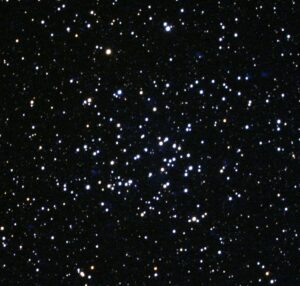NGC 3960 is an open cluster located in the constellation of Centaurus. Its age is estimated to be intermediate, and it was discovered by Scottish astronomer James Dunlop in 1834. Notably, NGC 3960 is located at a distance of approximately 7,360 light-years from the solar system and has an apparent size of 7.0 arcminutes, making it a relatively compact cluster.
Using the results of a study by Kharchenko et al. in 2013, which determined that NGC 3960 is located at a distance of approximately 2.9 kiloparsecs and has a proper motion of around 4.4 mas/yr, I conducted my own observation of the cluster. With telescopes PROMPT-MO-1, Prompt2, and Prompt5, I collected a total of 15 images of NGC 3960 in three different filters (B, V, and R) with a total exposure duration of 130, 60, and 30 seconds in each respective filter. Other imaging parameters were used and Skynet was utilized in the data collection process. In my analysis, I estimated the motion in RA to be 6.469 ± 0.53 (mas/yr), Motion in DEC to be 1.79 ± 0.495 (mas/yr), Distance to be 2.89kpc ± 30.01%, log (Age) to be 8.07(yr), Metallicity to be -0.13 solar, and E(B-V) to be 0.66 mag.

Figure 1. Cluster pro plus graphs of NGC 3060

Figure 2. ISM-reddened image of NGC 3060

Figure 3. De-reddened image of NGC 3960
In conducting my own observation of NGC 3960, I was able to estimate several properties and characteristics of the cluster, including its motion in RA and DEC, distance, log (Age), metallicity, and E(B-V). One interesting finding in my analysis was the relatively high value of E(B-V), indicating significant dust extinction in the line of sight to the cluster. Additionally, my analysis revealed the presence of blue stragglers in the cluster, which are stars that appear younger and bluer than their surroundings and are thought to result from stellar interactions and mergers. The presence of blue stragglers can provide important information about the history and evolution of the cluster.
Overall, this project was a challenging but rewarding experience that allowed me to deepen my understanding of the techniques and methods used in astronomical observation and analysis. Comparing my results with those of the Kharchenko et al. study provided valuable insights and highlighted the importance of collaborative and interdisciplinary research in advancing our understanding of the universe.